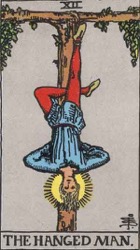The Hanged Man Tarot Card Meaning & Interpretations

The Hanged Man in its simplest interpretation is waiting for something or just feeling purposeless and directionless. Like sitting in a waiting room trying to patiently pass the time until your moment comes. Patience is a key component to this card as it is letting you know there is nothing you can do but wait. This is the most common message Tarot uses this card for. It is however worth exploring its dark origins, evolution and spiritual symbolism for deeper insights and meanings.
 In the traditional Tarot decks, like the Marseilles Tarot, The Hanged Man was based on the Italian Pittura infamante which means defaming portrait. During the late middle ages in Italy municipal governments commissioned these images to remind their citizens of the punishment for traitors, thieves, bankruptcy and fraud. To be hung, instead of being beheaded, wasn't just a slow and painful death but also considered shameful and was meant to humiliate those convicted and their families. In a devoutly catholic country like Italy the parallel between hanging and Judas, who betrayed Jesus, would have been well understood. Some traditional and modern depictions of this card include the man wearing a purse of money in reference to the silver Judas received for his betrayal. The money may be falling from the purse symbolising financial loss or depreciation. From these dark origins one could interpret the meaning of The Hanged Man as propaganda, shaming someone or punishment.
In the traditional Tarot decks, like the Marseilles Tarot, The Hanged Man was based on the Italian Pittura infamante which means defaming portrait. During the late middle ages in Italy municipal governments commissioned these images to remind their citizens of the punishment for traitors, thieves, bankruptcy and fraud. To be hung, instead of being beheaded, wasn't just a slow and painful death but also considered shameful and was meant to humiliate those convicted and their families. In a devoutly catholic country like Italy the parallel between hanging and Judas, who betrayed Jesus, would have been well understood. Some traditional and modern depictions of this card include the man wearing a purse of money in reference to the silver Judas received for his betrayal. The money may be falling from the purse symbolising financial loss or depreciation. From these dark origins one could interpret the meaning of The Hanged Man as propaganda, shaming someone or punishment.
With the publication of the Rider Waite Smith (RWS) deck The Hanged Man evolved into a more positive card due to some subtle changes made by the artist, Pamela C. Smith. Traditional Tarot decks had depicted the man hung on gallows (two upright poles joined at the top by a horizontal pole) but Smith changed this to the Christian Tau cross. She also placed a halo of light, or Nimbus as A.E. Waite refers to it as, behind the head of the man. This small detail dramatically changes the mood and meaning of the card from its traditional traitor, and shame, to one of someone who is holy or sacred. Depending on the Tarot deck you are using the meaning of The Hanged Man can be significantly different depending on these small details and attention should always be paid to them.
The Hanged Man of the RWS deck, and its modern derivatives, symbolises self sacrifice but its symbolism does not belong solely to Christianity. The halo is found not just in Christian art, and symbolism, but also in the East as well as the West. Images and statues of Buddha commonly incorporate a halo behind his head. The cross, and its symbolism of self sacrifice, is also found in Norse religion where Odin is said to have voluntarily sacrificed himself on the Yggdrasil tree to gain wisdom. If you are using Tarot for divination on a spiritual level the meaning of this card may be interpreted as an indicator of what you must do to gain wisdom and enlightenment, e.g. Giving up something or putting the needs of others before yourself. Taking the theme of humiliation from the card's Italian origins it could have the spiritual meaning of humbling, and reducing, the ego allowing consciousness to rise.
The Numerology of the The Hanged Man, as the 12th card of the Major Arcana, is based on the number 3 as numerology reduces 12 to 3 (1+2). The number 3 is the number of self expression and creativity. This may seem like a strange connection between a card that depicts a man hung by a leg to such happy and positive cards such as the 3 Of Cups or 3 Of Pentacles. Remembering that this card is about sacrifice, giving up one thing to be able to gain something else, the connection and meaning becomes more obvious. To create something new sometimes we are required to destroy, or let go of, what we currently have. We need to make space for the new by clearing away the old first. The next card after The Hanged Man, in the Major Arcana, is Death. Death is not the end but just part of the ever renewing cycle of life which exists to enable evolution.
The simplest interpretation and meaning of The Hanged Man could be having your world turned upside down, seeing things from a new perspective, letting go of one thing (sacrifice) in order to gain something else or being a martyr to a cause.
© Phuture Me Ltd 2010-2019. All rights reserved.
THE PICTORIAL KEY TO THE TAROT
By Arthur Edward Waite (1911)
The gallows from which he is suspended forms a Tau cross, while the figure--from the position of the legs--forms a fylfot cross. There is a nimbus about the head of the seeming martyr. It should be noted (1) that the tree of sacrifice is living wood, with leaves thereon; (2) that the face expresses deep entrancement, not suffering; (3) that the figure, as a whole, suggests life in suspension, but life and not death. It is a card of profound significance, but all the significance is veiled. One of his editors suggests that Éliphas Lévi did not know the meaning, which is unquestionable nor did the editor himself. It has been called falsely a card of martyrdom, a card a of prudence, a card of the Great Work, a card of duty; but we may exhaust all published interpretations and find only vanity. I will say very simply on my own part that it expresses the relation, in one of its aspects, between the Divine and the Universe.
He who can understand that the story of his higher nature is imbedded in this symbolism will receive intimations concerning a great awakening that is possible, and will know that after the sacred Mystery of Death there is a glorious Mystery of Resurrection.
